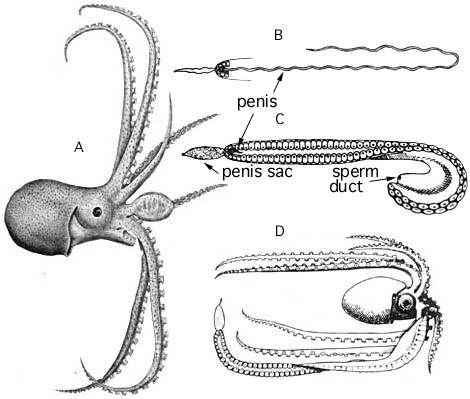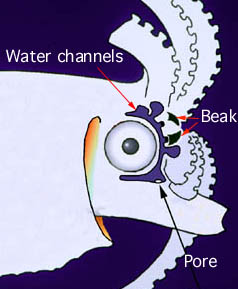- Arms
- Hectocotylus.
- Head
- Water pores.
- Viscera
- Swim bladder
The dwarf males are about one tenth the mantle length of mature females. As in all argonautoid families, males have a detachable hectocotylus; however, in contrast to males of the other families, the hectocotylus is not carried within a sac on the head but the within a sac that extends from the base of the hectocotylus. Apparently just prior to mating the hectocotylus breaks out of the sac.


Figure. Lateral views of the male O. tuberculata and it's hectocotylus. A - Male with hectocotylus coiled in a sac. Drawing from Young, 1972, 14 mm ML. B - Tip of hectocotylus with the penis-sac collapsed and penis extended. C - Detached hectocotylus with most of the penis in the penis-sac and just the tip of the penis emerging. Note the opening of the sperm duct at the opposite end of the arm. D- Male with attached hectocotylus that has broken free from its sac. Drawings B-D from Naef, 1923.
Two pores are present on the ventral surface of the head, one on either side of the funnel. Each pore opens into a channel that pass around the anterior margin of each eye with branches forming bladders between the bases of adjacent arms. Sea water enters the pores and fills the channels and bladders. The function of this system is unknown. However, the system could provide a slip-surface to allow the arms great freedom of movement without distorting the eyes. A free-swimming octopod in clear, near- surface waters, an environment that offers few hiding places, cannot afford to lose the use of its eyes for a moment because of the threat of large, fast-swimming predators.
Swimbladders are present in all argonautoids except Argonauta (Bizikov, 2004.
The swimbladder of Ocythoe connects to the mantle cavity via a muscular duct on the right side. The swimbladder is located at the center of mass just above the center of gravity, a position that allows for stability and manoeverability. The muscular swim-bladder sac is a distended bladder whose volume is about 5% of the total body volume. This volume is sufficient to provide neutral buoyancy when filled with gas. Indeed, observations on a living animal in the Naples Aquarium indicate that the octopus can achieve neutral buoyancy. The nature and origin of the gas that fills the bladder is unknown although the octopod has been observed to release bubbles of gas. The latter were presumably ejected via muscular action through the swimblader duct into the mantle cavity. The swimbladder is absent from the dwarf male. (The above account is from Packard and Wurtz, 1994).





 Go to quick links
Go to quick search
Go to navigation for this section of the ToL site
Go to detailed links for the ToL site
Go to quick links
Go to quick search
Go to navigation for this section of the ToL site
Go to detailed links for the ToL site